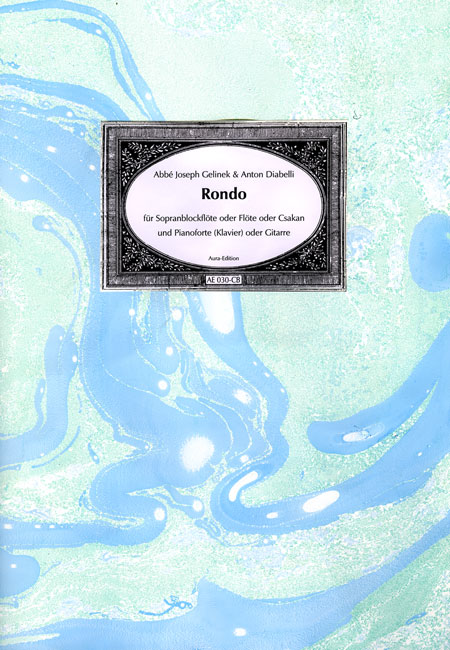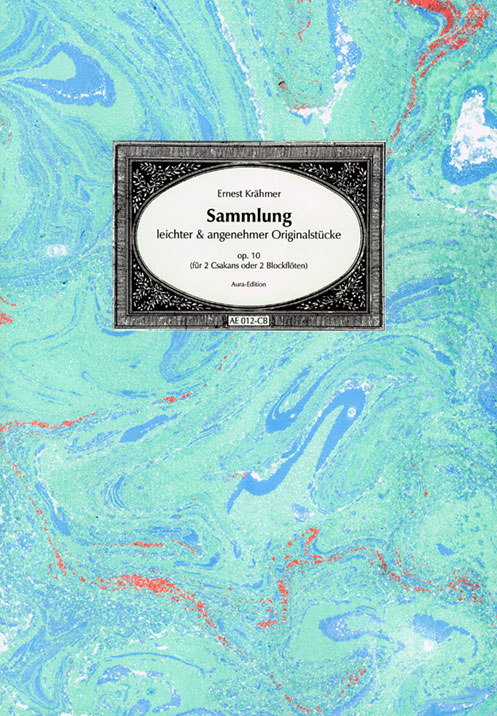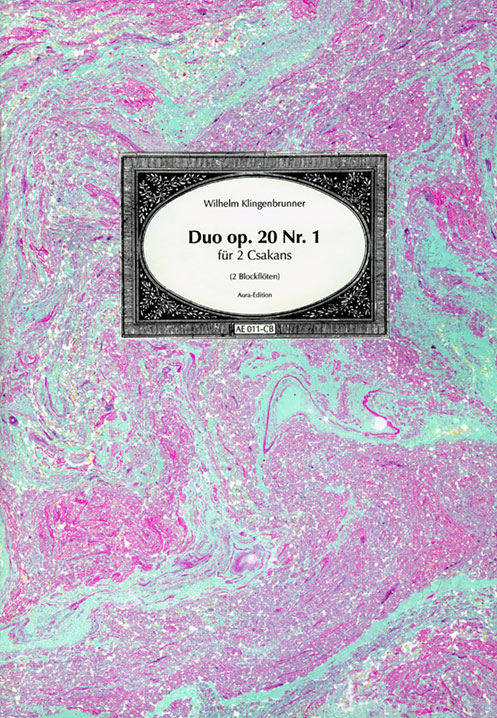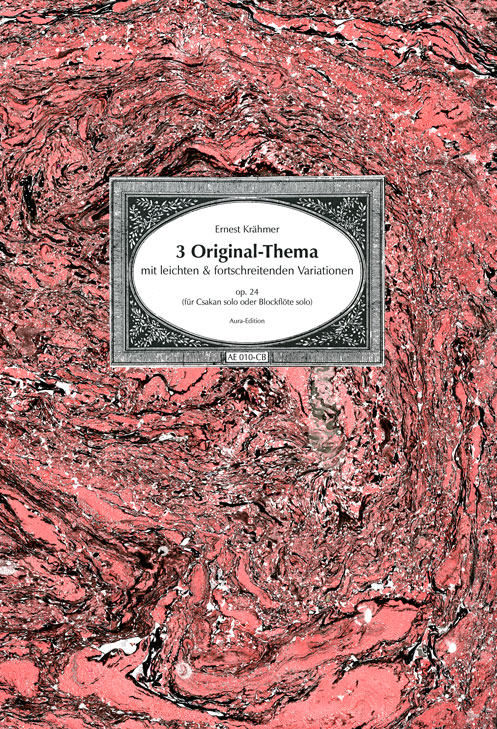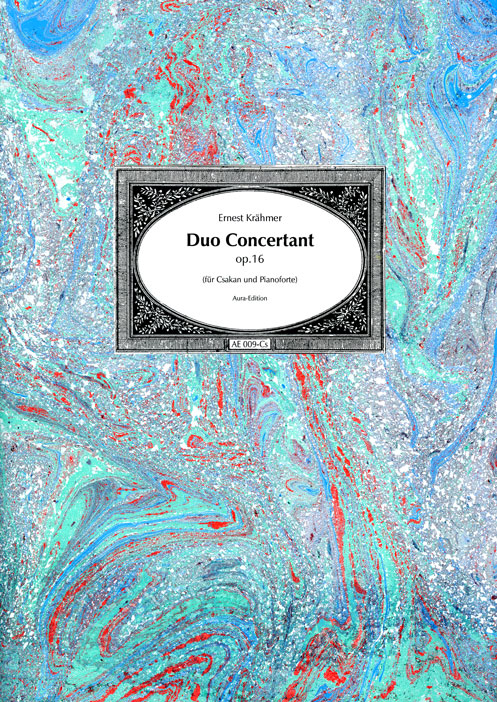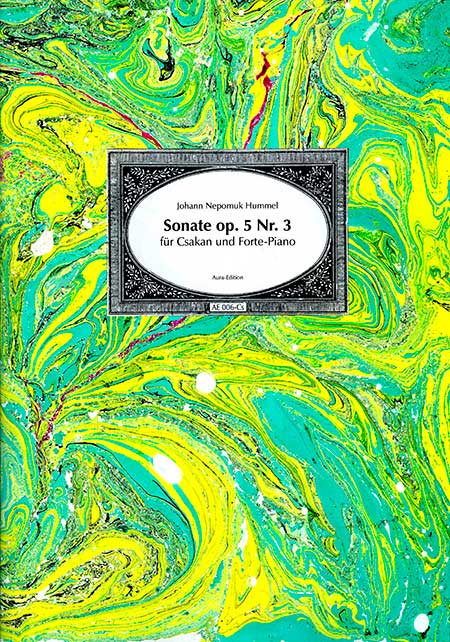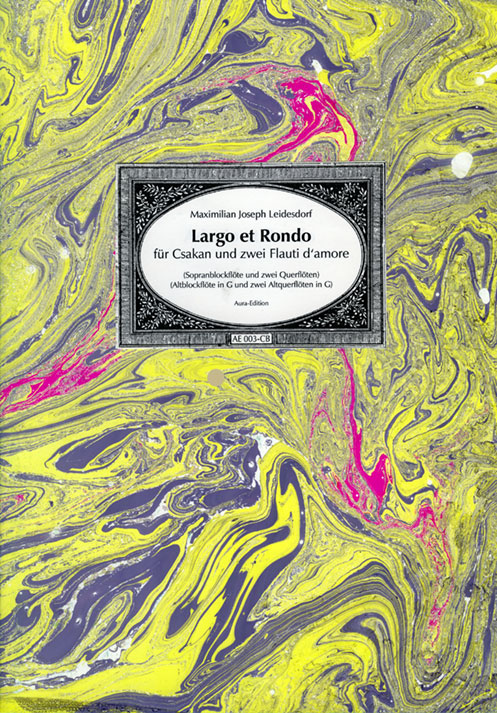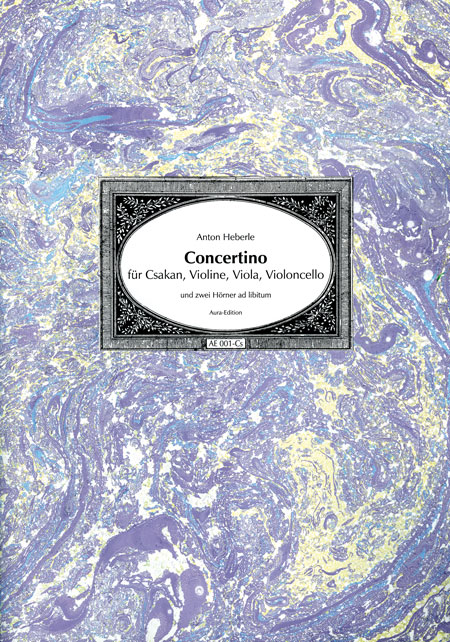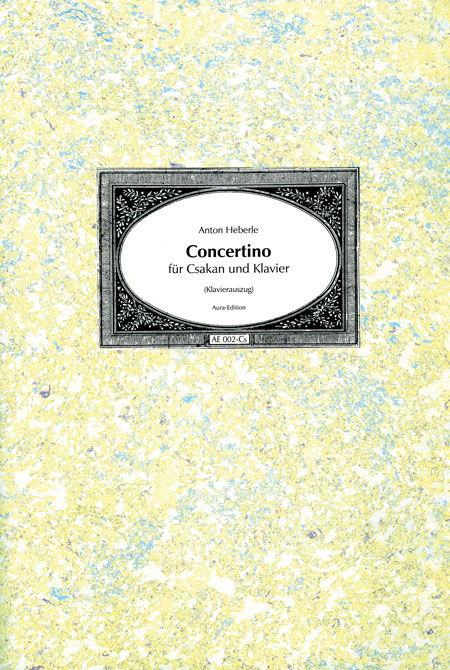Sheet Music for Csakan
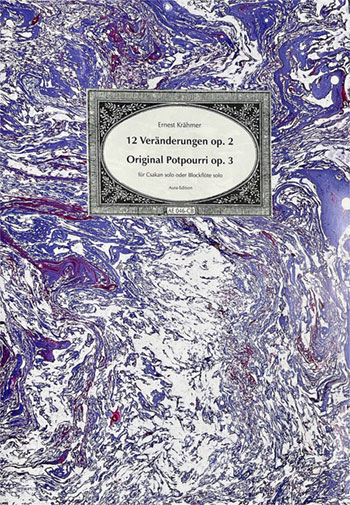 Ernest Krähmer (1795–1837)
Ernest Krähmer (1795–1837)
Zwölf Veränderungen op. 2 (1822)
Original Potpourri op. 3 (1822)
for recorder solo or Csakan solo
Aura-Edition AE 046-CB, solo part, € 14,00
During the 1820s, the early-romantic recorder conquered many musical stages. For this, players required new playing techniques, and they also needed new pieces. Ernest Krähmer, main protagonist of the instrument, created as "warm-up exercises" his "12 changes" op. 2 which are presented here for the first time in modern edition. The structural diversity of his medley op. 3 (Krähmer's first bigger solo work) was setting new standards. It can be considered one of the first original recorder solos for the concert. Its first edition was carefully revised, and a comprehensive preface comments the rich musical material.
Sound Sample 1:
Sound Sample 2:
Link to the sheet music example 1
Link to the sheet music example 2
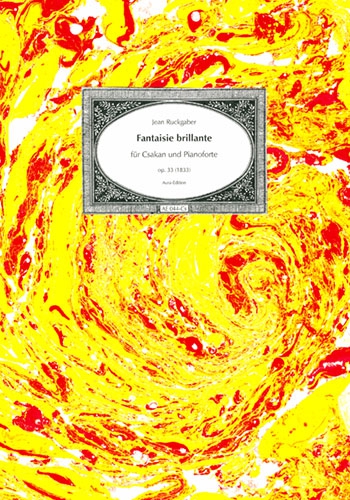 Jean Ruckgaber (1799–1876)
Jean Ruckgaber (1799–1876)
Fantaisie brillante op. 33 (1833)
for Csakan and Pianoforte
First edition, presented by Peter Thalheimer
Aura-Edition AE 044-Cs, Csakan part & score for Pianoforte, € 20,00
As a pupil of Johann Nepomuk Hummels and later director of the Lemberg conservatory, Jean Ruckgaber was in touch with composers such as Franz Xaver Mozart, Chopin and Liszt.
Following the publication of his op. 34, we are presenting his Fantasy op. 33 here for the first time. Also a piece for the Csakan recorder and Pianoforte, it is a likewise technically and musically rewarding concert work for both players.
Written towards the end of the Csakan's epoch and gleaming from vitality and musical ideas, the Fantasy's free episodes lead to a vibrant Polacca.
Sound Sample:
Link to the sheet music example
Link to the foreword (in German)
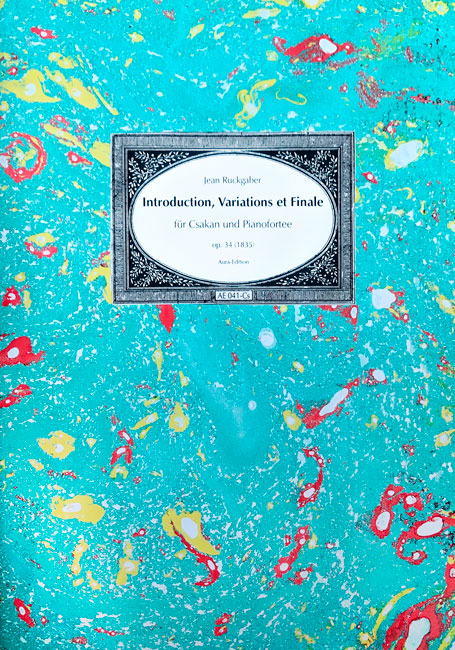 Jean Ruckgaber (1799–1876)
Jean Ruckgaber (1799–1876)
Introduction, Variations et Finale op. 34 (1835)
for Csakan und Pianoforte
First edition, presented by Peter Thalheimer
Aura-Edition AE 041-Cs, Csakan part & score for Pianoforte, € 22,00
As a pupil of Johann Nepomuk Hummels and later director of the Lemberg conservatory, Jean Ruckgaber was in touch with composers such as Franz Xaver Mozart, Chopin and Liszt.
His first-edited piece for the Csakan recorder and Pianoforte is a technically and musically rewarding concert work for both players.
Written towards the end of the Csakan's epoch, these character variations are based on a song-like theme in the romantic gesture. After the introduction with recitativo elements, the variations are enriched with piano interludes and notated cadences. The final Presto is set as a whirling finale.
Sound-Sample:
Link to the sheet music example
Link to the foreword (in German)
Order at Mollenhauer-Shop (in German)
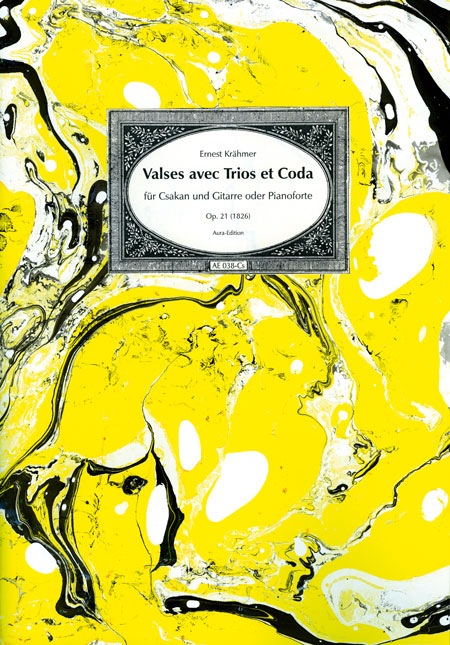 Ernest Krähmer (1795–1837)
Ernest Krähmer (1795–1837)
Valses avec Trios et Coda op. 21 (1826)
for Csakan in A flat and Pianoforte or guitar
Aura-Edition AE 038-Cs, two scores and part for Csakan and guitar, € 22,00
This charming waltz suite includes waltzes and their trios in various character. It is equal to Schubert's well-known waltz collection in the arrangement for flute and guitar by Diabelli.
Just the original part of the waltzes' melody seems to have survived. On the basis of its high musical potential, Nik Tarasov has written accompanying parts for piano and guitar in period style.
The collection is published here true to its original conception.
The editor's preface contains information for the performance practice of the probably most important dance form of its epoch.
Sound sample of the sheet music with Guitar:
Sound sample of the sheet music with Pianoforte:
Link to the sheet music example no. 1
Link to the shee music example no. 2
Link to the foreword (in German)
Order at Mollenhauer-Shop (in German)
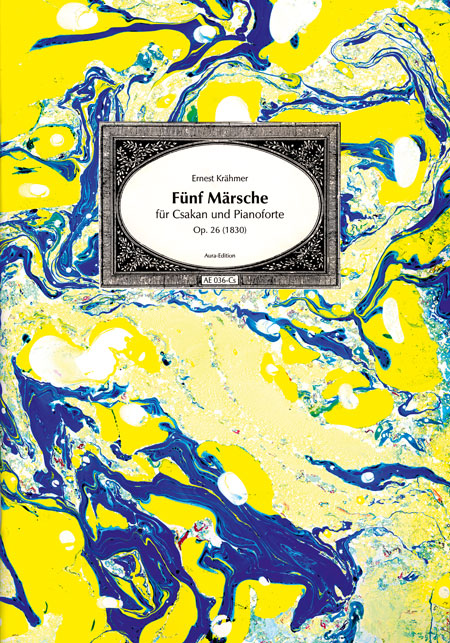 Ernest Krähmer (1795–1837)
Ernest Krähmer (1795–1837)
Fünf Märsche (Five Marches) op. 26 (1830)
for Csakan in A flat and Pianoforte
Aura Edition, AE 037-Cs, piano score and Csakan part, € 20,00
The short rhythmical character pieces consist each of opposing parts: a rousing march theme is combined with a contrasting trio. In a manageable musical framework, structured, solemn and precisely articulated rhythms encounter lyrical lines and smooth, sensitive moments.
Presenting essential gestures of the musical Romanticism, the pieces are suitable as exercise material in skillfully settings.
Having been formerly incomplete, their parts were rediscovered in different locations in 2019 by the editor and reassembled for the first time in the present modern edition by maintaining their original tonalities.
Sound Samples:
Link to the sheet-music example
Link to the foreword (in German)
Order at Mollenhauer-Shop (in German)
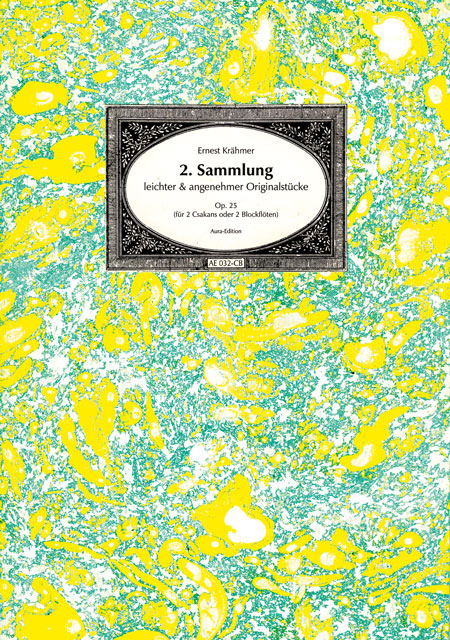 Ernest Krähmer (1795–1837)
Ernest Krähmer (1795–1837)
2. Sammlung (2nd Collection)
Second Collection of easy and pleasant original pieces op. 25 (1830)
for two Csakans (two recorders)
Aura-Edition AE 032-CB, playing score, € 16,00
Due to the success of his first collection of duets op. 10 from 1824, Krähmer added in 1830 a second set of original pieces op. 25 for two Csakan recorders. Again, these miniatures serve as an introduction into the musical style of the early Romantic period. From a pedagogical point of view, the pieces are perfectly worked out along the characteristics of the recorder – with carefully placed articulation, in the common range of two octaves, with wise dynamical marks, clear phrasing and movements in varying tempo.
Sound Sample:
Link to the sheet-music example
Link to the foreword (in German)
Order at Mollenhauer-Shop (in German)
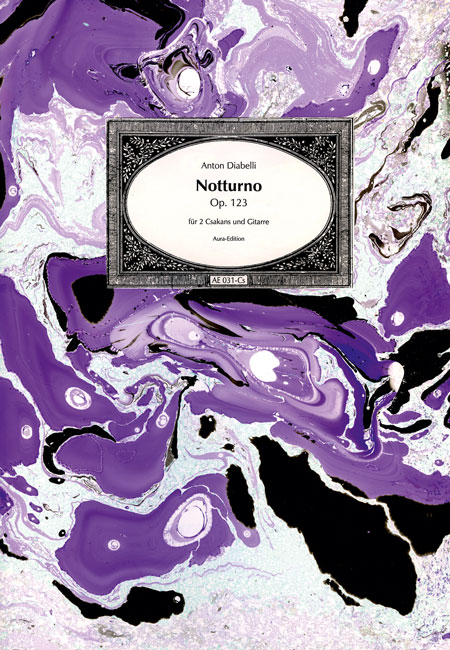 Anton Diabelli (1781–1858)
Anton Diabelli (1781–1858)
Notturno op. 123 (1821)
for 2 Csakans and guitar
Aura Edition, AE 031-Cs, score and three instrumental parts, € 23,00
The demanding and imaginative composition ranks among the best original chamber-music works of the romantic recorder.
Diabelli dedicated it to Ernest Krähmer, the most important player of the Csakan in his day.
The five-movement Notturno is scored in an extraordinarily wide range of forms and shows the composer's whole mastery with looks towards Schubert.
The present modern edition makes the work accessible for the recorder's repertory.
Sound Sample:
Link to the sheet-music example
Link to the foreword (in German)
Order at Mollenhauer-Shop (in German)
Abbé Joseph Gelinek (1758–1825) & Anton Diabelli (1781–1858)
Rondo (1812/1813)
for soprano recorder or flute or Csakan in A flat and Pianoforte (piano) or guitar
Aura Edition, AE 030-CB, piano score und parts for recorder (flute, oboe) or Csakan and guitar, € 21,00
Gelinek's Rondo in concertante form from the early years of the Viennese romantic recorder movement of the 1810s is presented here for the first time in both its original versions.
The first version of the composer with Pianoforte was followed by Anton Diabelli's guitar setting which skillfully takes advantage of the instrument's technical possibilities. According to the used accompanying instrument and the tonality, the texture allows the choice of various melody instruments, like the Csakan recorder in A flat, a traditional recorder in C or a flute.
Two Sound Samples:
Link to the sheet musci example no. 1
Link to the sheet music example no. 2
Link to the foreword (in German)
Order at Mollenhauer-Shop (German)
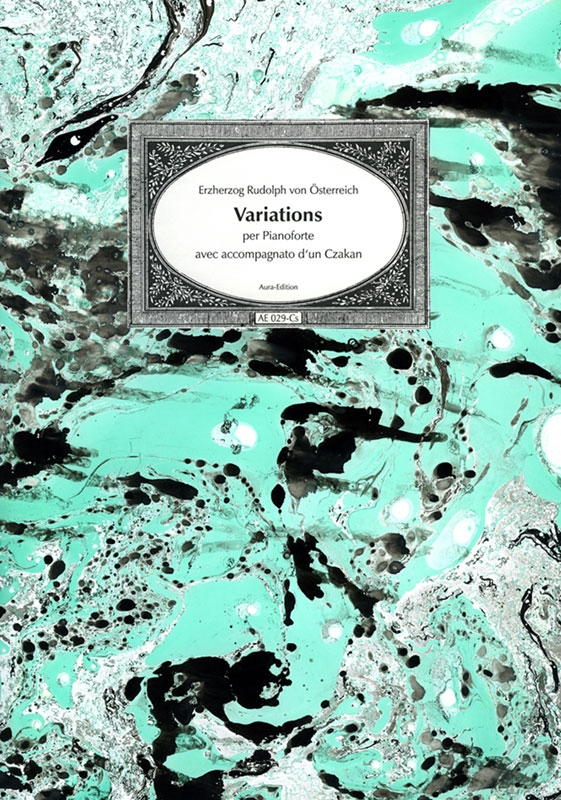 Erzherzog Rudolph von Österreich (1788–1831)
Erzherzog Rudolph von Österreich (1788–1831)
Variations per Pianoforte avec accompagnato d’un Czakan (ca 1810)
for Pianoforte and Csakan in A flat
First Edition
Aura-Edition AE 029-Cs, Csakan part & piano score, € 20,00
This effective and rewarding concert work includes a set of diversified character variations.
Being Beethoven’s piano pupil having also lessons in composition with the master, Archduke Rudolph of Austria wrote a set of variations for the Pianoforte particularly for himself with accompaniment of the Csakan. Both character and setting of the variations are very much influenced by Beethoven, and especially the piano part deserves a good player.
The work was published 2003 in first edition by Friedrich Hofmeister Musikverlag under FH 2842, in a version transposed a major third up from A flat major to C major for piano and descant recorder.
Sound Sample:
Link to the sheet-music example
Link to the foreword (in German)
Order at Mollenhauer-Shop (in German)
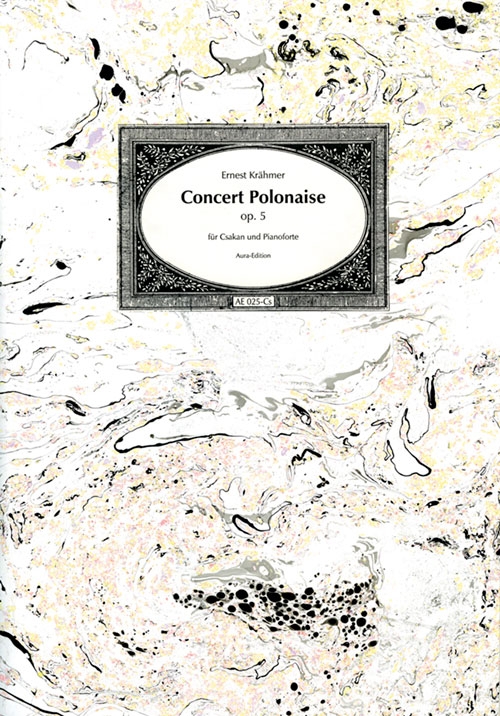 Ernest Kraehmer (1795–1837)
Ernest Kraehmer (1795–1837)
Concert Polonaise op. 5 (1822)
for Csakan in A flat and Pianoforte
Aura-Edition AE 025-Cs, Csakan part & piano score, € 22,00
This demanding concertante piece from Krähmer’s successful year 1822 is surely one of the main works of the Csakan’s repertory.
The central gesture of this multi-part movement is worked out in the character of a Polonaise. Its typical performance is described by the editor in the preface along a selection of historical musicological sources. Apart from the version with piano accompaniment there is another original setting with string orchestra which is published in the same series under AE 028-Cs.
Sound Sample:
Link to the sheet-music example
Link to the foreword (in German)
Order at Mollenhauer-Shop (in German)
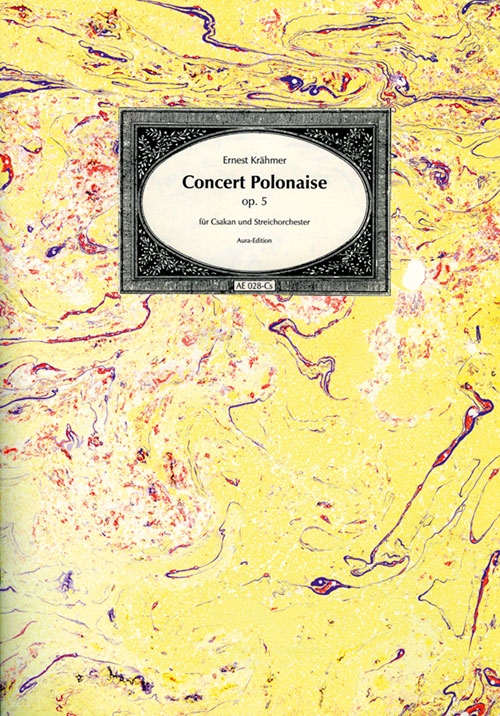 Ernest Kraehmer (1795–1837)
Ernest Kraehmer (1795–1837)
Concert Polonaise op. 5 (1822)
for Csakan in A flat and string orchestra
Aura-Edition AE 028-MB, Csakan part, all string parts, score, € 25,00
This demanding piece from Krähmer’s successful year 1822 represents his first major concertante work with accompaniment of the string orchestra.
The central gesture of this multi-part movement is worked out in the character of a Polonaise. Its typical performance is described by the editor in the preface along a selection of historical musicological sources. Apart from the setting with string orchestra there is also an original version with piano accompaniment which is published in the same series under AE 025-Cs.
Sound Sample:
Link to the sheet-music example
Link to the foreword (in German)
Order at Mollenhauer-Shop (in German)
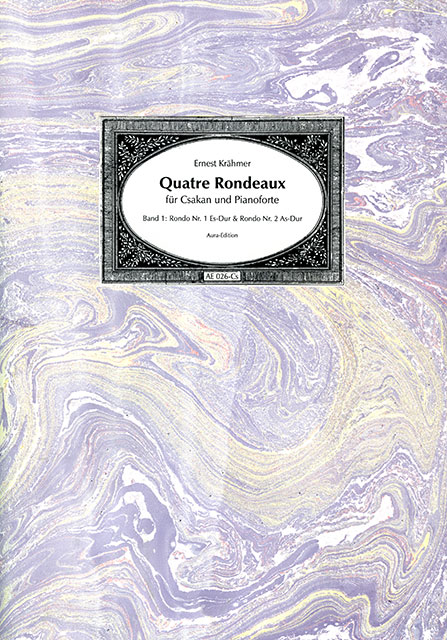 Ernest Kraehmer (1795–1837)
Ernest Kraehmer (1795–1837)
Quatre Rondeaux op. 33 (1834)
Volume 1: Rondo no. 1 E-flat major & Rondo no. 2 A-flat major.
for Csakan and pianoforte
Aura-Edition AE 026-Cs, Csakan part & piano score, € 22,00
Central and demanding work of the Csakan repertoire in concertante form.
The long-lost piano part has been rediscovered 2017 – the rondos can be now published in their original texture.
Volume 1 contains the charming Rondo no. 1 in E-flat major in a pastoral-like gesture, which finishes in a dance-like finale, briefly citing elements from Spanish national dances admired in these days. Rondo no. 2 in A-flat major is one of the most thrilling and sparkling works from Krähmer’s oeuvre. The repeating march-like main theme is bursting with energy; the musical interludes are varying from a dramatic section to extremely playful and virtuoso passages.
Sound Sample of Rondo 1:
Sound Sample of Rondo 2:
Link to the sheet-music example (Rondo 1)
Link to the sheet-music example (Rondo 2)
Link to the foreword (in German)
Order at Mollenhauer-Shop (in German)
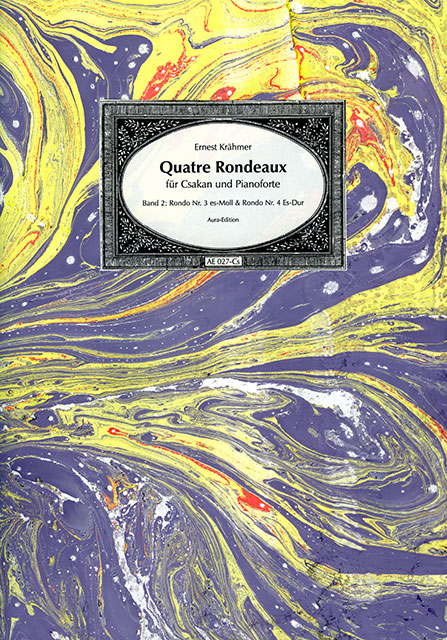 Ernest Kraehmer (1795–1837)
Ernest Kraehmer (1795–1837)
Quatre Rondeaux op. 33 (1834)
Vol 2: Rondo no. 3 in E-flat minor & Rondo no. 4 in E-flat major
for Csakan and pianoforte
Aura-Edition AE 027-Cs, Csakan part & piano score, € 22,00
Central and demanding work of the Csakan repertoire in concertante form.
The long-lost piano part has been rediscovered 2017 – the rondos can be now published in their original texture.
Volume 2 comprises the touching Rondo no. 3 in E-flat minor, which is without doubt one of the most substancial works of Krähmer: the lamenting main theme is juxtaposed with other emotional and cantable or dance-like episodes. But not enough: the main theme mutates into a relaxed major key and ends by an energetic coda. The multi-level Rondo no. 4 in E-flat major works like a recollection of most popular musical thoughts of these days. After a general pause, the piece ends in an almost symphonic manner, and, as often the case in Krähmer’s oeuvre, in a Mozart-like finale.
Sound Sample of Rondo 3:
Sound Sample of Rondo 4:
Link to the sheet-music example (Rondo 3)
Link to the sheet-music example (Rondo 4)
Link to the foreword (in German)
Order at Mollenhauer-Shop (in German)
 Wolfgang Amadeus Mozart (1756–1791)
Wolfgang Amadeus Mozart (1756–1791)
Divertimento II from KV 439 b
for 2 Csakans (2 clarinets in A) and guitar
or alto recorder, tenor recorder and great-bass recorder in C (basson/violoncello/viola)
Aura-Edition AE 023-CB, parts for 2 Csakans (3 recorders or violoncello/basson) and viola, piano score & guitar part, € 22,00
Adaption of the most popular and often arranged trios for recorder trio or two Csakans and guitar.
Following numerous arrangements of Mozart works from the early-romantic period for various recorder-like instruments, editor Helmut Schaller detected this attractive trio as suitable for the recorder repertoire of today. As no modifications of the original text are necessary, this music of outstanding quality is directly accessible to the players and represents a rewarding object of study.
Sound Sample:
Link to the sheet-music example no. 1
Link to the sheet-music example no. 2
Link to the foreword (in German)
Order at Mollenhauer-Shop (in German)
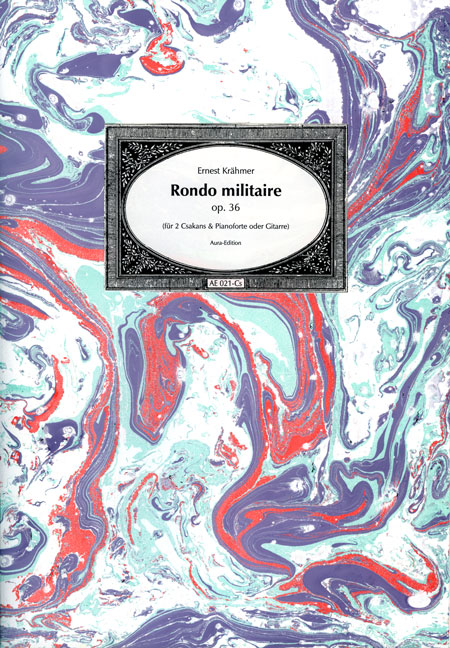 Ernest Krähmer (1795–1837)
Ernest Krähmer (1795–1837)
Rondo militaire op. 36 (1836)
for two Csakans and pianoforte or guitar
or two clarinets in A (two soprano recorders) and guitar
Aura-Edition AE 021-Cs, parts for 2 Csakans (clarinets) and guitar, piano score, € 22,00
First modern edition of this long-lost work in rare combination of two Csakans and accompaniment.
As is common in rondo forms, spirited rhythms and jagged articulation of the part A of the main theme contrast with partially diverging intermediate sections, the latter comprising playful, lyrical and yearning moments.
One of the remarkable things is the dual form of this composition, overlapping rondo form and sonata-movement form.
Sound Sample:
Link to the sheet-music example no. 1 (with piano)
Link to the sheet-music example no. 2 (with guitar)
Link to the foreword (in German)
Order at Mollenhauer-Shop (in German)
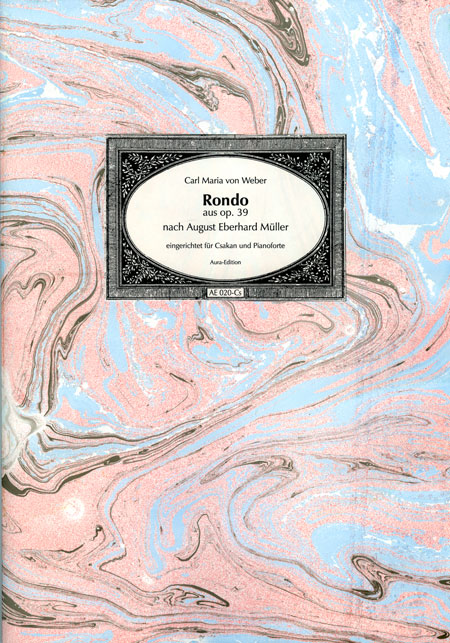
Carl Maria von Weber (1786–1826)
Rondo from op. 39 (1817)
after an arrangement by August Eberhard Müller
adapted for Csakan and pianoforte
Aura-Edition AE 020-Cs, Csakan part & piano score, € 20,00
Challenging arrangement of high musical quality for ambitious duo partners which follows the tradition of period arrangements of this kind.
Like explained by Nik Tarasov in his foreword to the arrangement of Weber’s Rondo from op. 39, music by Weber was appreciated much by players of the Csakan. Since, however, just arrangements for amateurs have survived in this context, the editor has provided a concertante work for a more in depth study of the romantic style. This version is orientated on an arrangement set by the Weimar court conductor August Eberhard Müller, who scored Weber’s op. 39 for transverse flute and pianoforte. Based on the Csakan’s central key A flat, this graceful chromatic rondo theme, together with its harmonically advanced development and expressive intermediate sections equally challenges both players.
Sound Sample:
Link to the sheet-music example
Link to the foreword (in German)
Order at Mollenhauer-Shop (in German)
Stephan Franz (1785–1855)
Pot-Pourri op. 13 (1816)
for Csakan (soprano/descant recorder or flute), viola, violoncello, and guitar
Aura-Edition AE 017-CB, 5 parts & score, € 25,00
This is the first modern edition of this unique and musically attractive work of the chamber music repertoire. The original csakan part has been complemented with a transposed version for the recorder which is also suitable for the flute.
This versatile quartet, set in the style of a potpourri, offers a good insight into the chamber music activities of the Biedermeier period in Vienna. Similar to the Grand Duo, the technical demands of op.13 clearly exceed amateur level.
Sound Sample:
Link to the sheet-music example
Link to the foreword (in German)
Order at Mollenhauer-Shop (in German)
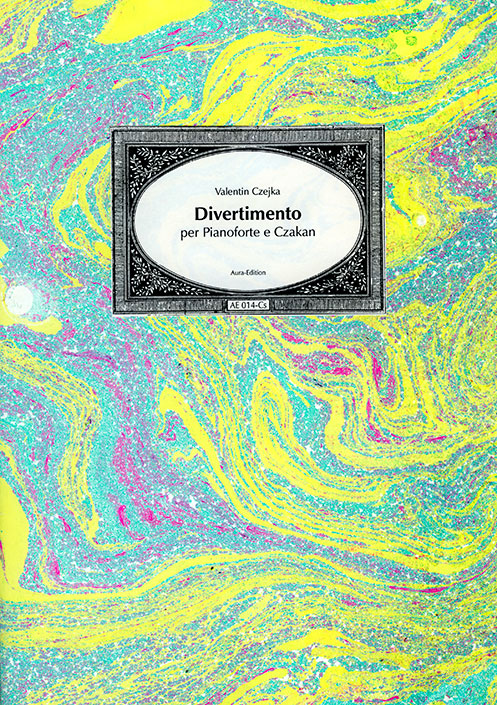
Valentin Czejka (1769–ca. 1834)
Divertimento
per Pianoforte e Czakan
First Edition
Aura-Edition AE 014-CS, Csakan part & piano score, € 20,00
The demanding piano part of this duo with Csakan is a concertante work, dating probably from around 1810 and performed only at court, which is the reason it has not been printed before.
These days it still requires a versatile pianist for the virtuosic passages but also for performing the sections that enter into a dialogue with the melody instrument.
Valentin Czejka was one of the best professional musicians of Vienna, favoured by Beethoven as a bassoon virtuoso, and a prolific composer.
Sound Sample:
Link to the sheet-music example
Link to the foreword (in German)
Order at Mollenhauer-Shop (in German)
Ernest Krähmer
Sammlung (Collection)
Collection of easy and pleasant original pieces op. 10 for two Csakans (two recorders)
Aura-Edition AE 012-CB, playing score, € 15,00
This collection of short pieces, published in 1824, is a musically inspired introduction to the early romantic recorder repertoire, but in miniature. However, the duets are also suitable as short concert items. This is a selection of short pieces, in different tempi and in recorder friendly major and minor keys, in a very compact form. They introduce cantabile themes, sprightly dances such as minuet and trio, Ländler and the syncopated polacca, as well as the rondo and a set of variations, all within the range of two octaves. Musical gestures and the most popular articulation patterns of this period will become familiar by playing these pieces.
Sound Sample:
Link to the sheet-music example
Link to the foreword (in German)
Order at Mollenhauer-Shop (in German)
Wilhelm Klingenbrunner
Duo op. 20 no. 1
for two Csakans (two recorders)
Aura-Edition AE 011-CB, playing score, € 14,00
The first extensive movement of this Csakan duet, published in 1812, is in sonata form. There follows a short snappy polonaise with the familiar stress on the second beat of the bar, and an even shorter but no less playful trio. The final movement is a theme with four variations and a coda, starting unexpectedly, which paraphrases the theme in yodelling arpeggios and Ländler motifs.
Sound Sample:
Link to the sheet-music example
Link the foreword (in German)
Order at Mollenhauer-Shop (in German)
Ernest Krähmer
3 orignal themes
with variations ranging from easy to difficult, for Csakan solo or recorder solo op. 24
Aura-Edition AE 010-CB, Csakan part, € 12,00
This collection offers three sets of variations on themes of differing characters, for csakan or recorder solo: the variations on a waltz, a cantabile theme in the style of Mozart, and Alpine motifs carry precise phrase and dynamic markings. A successful symbiosis of pedagogic studies and concertante original music. This compilation offers the sets of variations in a complete new edition for the first time.
Sound Sample:
Link to the sheet-music example
Link to the foreword (in German)
Order at Mollenhauer-Shop (in German)
Ernest Krähmer
Duo Concertant for Csakan & pianoforte op. 16
Aura-Edition AE 009-Cs, Csakan part & piano score, € 25,00
This piece in three movements contains a movement in sonata form, a cantabile middle movement and a Mozartian Rondo. In contrast to many other works by Krähmer the piano part does not only have an accompanying function but enters into a dialogue with the Csakan in a concertante manner. Comparable to works by Carl Maria von Weber, this piece is a good example of high-quality original early romantic music for the Csakan, gratifying for player and listener alike.
Sound Sample:
Link to the sheet-music example
Link to the foreword (in German)
Order at Mollenhauer-Shop (in German)
Johann Nepomuk Hummel
Sonata for Csakan and pianoforte
Aura-Edition AE 006-Cs, Csakan part & piano score, € 23,00
Hummel’s well-known sonata for viola and pianoforte is very suitable for performance on the Csakan both due to its key signature (E-flat major) and the structure of its themes. This composition combines the musical influence of Hummel’s mentor, Wolfgang Amadeus Mozart, with the early romantic ideas becoming fashionable at the time, into a charming and demanding duo which assigns the csakan both accompanying and soloistic roles while the piano flourishes throughout.
Sound Sample:
Link to the sheet-music example
Link to the foreword (in German)
Order at Mollenhauer-Shop (in German)
Maximilian Joseph Leidesdorf (1787–1840)
Largo et Rondo
Trio for Csakan and two flauti d'amore (or soprano recorder and two flutes, or alto recorder in G and two alto flutes in G).
First Edition
Aura-Edition AE 003-Cs, score and three parts, € 19,00
This is the first edition of this trio, originally scored for Csakan and two flauti d’amore.
The pleasant and technically demanding work, from the repertoire of a Viennese flute ensemble from around 1800, deserves to be revived in recorder circles after lying dormant for almost 200 years. This edition can also be used for performance with alternative instrumentation: for soprano/descant recorder and two modern flutes, or alto/treble recorder in G and two modern alto flutes in G.
A version for three recorders is available as AE 005-MB.
Sound Sample:
Link to the sheet-music example
Link to the foreword (in German)
Order at Mollenhauer-Shop (in German)
Anton Heberle (1807)
Concertino
for Csakan, violin, viola, violoncello and two horns ad lib.
Reprint
Aura-Edition AE 001-Cs, score with 6 parts, € 25,00
Heberle’s Concertino is, without doubt, a key work of the Csakan repertoire. The composition has survived in two sources: as a manuscript and also as individual printed parts from the 19th century. The current reprint offers both score and individual parts in a reliable edition for performers for the first time.
The piano reduction is available as AE 002-Cs.
Sound Sample:
Link to the sheet-music example
Link to the foreword (in German)
Order at Mollenhauer-Shop (in German)
Anton Heberle (1807)
Concertino
for Csakan and pianoforte
(after the Concertino for Csakan, violin, viola, violincello and two horns ad lib.)
Aura-Edition AE 002-Cs, piano reduction & csakan part, € 19,00
Heberle’s Concertino is, without doubt, a key work of the Csakan repertoire. This piano reduction and solo part is suitable for study purposes. The original ensemble version (score and parts) is available as AE 001-Cs.
Sound Sample:
Link to the sheet-music example
Link to the foreword (in German)
Order at Mollenhauer-Shop (in German)







